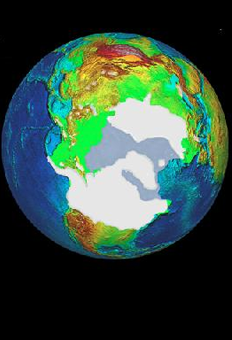NOAA/WDS Paleoclimatology - Lake CF8 Arctic Surface Air Temperature Reconstructions through the Holocene
This archived Paleoclimatology Study is available from the NOAA National Centers for Environmental Information (NCEI), under the World Data Service (WDS) for Paleoclimatology. The associated NCEI study type is Climate Reconstruction. The data include parameters of climate reconstructions|insect|paleolimnology with a geographic location of Nunavut, Canada. The time period coverage is from 11464 to -55 in calendar years before present (BP). See metadata information for parameter and study location details. Please cite this study when using the data.
- Cite as: Axford, Y.; Briner, J.P.; Francis, D.R.; Miller, G.H.; Walker, I.R.; Wolfe, A.P. (2020-04-15): NOAA/WDS Paleoclimatology - Lake CF8 Arctic Surface Air Temperature Reconstructions through the Holocene. [indicate subset used]. NOAA National Centers for Environmental Information. https://doi.org/10.25921/j9zb-st77. Accessed [date].
- Please refer to Credit tab for full citation information.
- doi:10.25921/j9zb-st77
- noaa-recon-30815
- NCEI DSI 1200_02
- NCEI DSI 1200_01
noaa-recon-30815
| Search Data |
|
| Download Data |
|
| Distribution Formats |
|
| Ordering Instructions | Contact NCEI for other distribution options and instructions. |
| Distributor | NOAA National Centers for Environmental Information
ncei.info@noaa.gov |
| Dataset Point of Contact | NOAA National Centers for Environmental Information
ncei.info@noaa.gov |
| Dataset Point of Contact | Data Center Contact
NOAA World Data Service for Paleoclimatology 828-271-4800 paleo@noaa.gov |
| Coverage Description | Date Range: 11464 cal yr BP to -55 cal yr BP; |
| Time Period | -9514 to 2005 |
| Spatial Bounding Box Coordinates |
N: 70.5569
S: 70.5569
E: -68.9519
W: -68.9519
|
| Spatial Coverage Map | |
| General Documentation |
|
| Associated Resources |
|
| Publication Dates |
|
| Data Presentation Form | Digital table - digital representation of facts or figures systematically displayed, especially in columns
|
| Dataset Progress Status | Complete - production of the data has been completed |
| Data Update Frequency | Data update frequency not available |
| Supplemental Information |
STUDY NOTES: This dataset was contributed as part of the Temperature-12k project (https://doi.org/10.25921/4RY2-G808). Data were contributed to the project from the original data generators, who are listed in the Investigator field of this template file. Additional notes regarding the use of these data in the Temperature-12k project can be found in the LiPD file listed as an Online_Resource of this template file. Note added by Temperature-12k authors: surface core and piston core spliced together
ABSTRACT SUPPLIED BY ORIGINATOR: Quaternary interglacial periods provide glimpses of a warmer Arctic and useful perspectives on possible future conditions, but records of Arctic terrestrial conditions over multiple interglacial periods are rare. Here, we take advantage of a site in the Canadian Arctic where lacustrine sediments representing the past three interglacial periods are preserved in an extant lake. We use subfossil insects (chironomids) preserved in this exceptional sedimentary archive to derive temperature reconstructions through the Holocene up to A.D. 2005, through the Last Interglacial sensu stricto (marine isotope stage or MIS 5e), and a portion of the penultimate interglacial (MIS 7). Chironomidinferred temperatures are warmest for the early Holocene and MIS 5e, two periods with enhanced Northern Hemisphere insolation forcing relative to today. Twentieth-century warming at this site apparently caused the recent extirpation of cold stenothermous chironomid taxa. Assemblages from MIS 5e have close analogs in modern training set data as determined by squared-chord distance, and MIS 5e species assemblages are very similar to Holocene assemblages at this site. MIS 7 sediments record summer temperatures similar to those of the mid- to late Holocene, followed by a descent into glacial conditions. Even MIS 7 chironomid assemblages, dating back ~200,000 yr, have close modern analogs. These lake sediments also provide direct evidence for a period of regional deglaciation between MIS 5e and the Holocene (most likely MIS 5a). To our knowledge, the data presented here represent the longest paleotemperature record thus far generated using chironomids. The existence of close modern analogs for ancient chironomid assemblages at Lake CF8 suggests that this method can provide useful paleotemperature estimates extending back hundreds of millennia. |
| Purpose | Records of past temperature, precipitation, and other climate variables derived from paleoclimate proxies. Parameter keywords describe what was measured in this data set. Additional summary information can be found in the abstracts of papers listed in the data set citations. |
| Dataset Citation |
|
| Cited Authors |
|
| Originators |
|
| Publishers |
|
| Theme keywords | Global Change Master Directory (GCMD) Science Keywords
|
| Data Center keywords | Global Change Master Directory (GCMD) Data Center Keywords
|
| Place keywords |
|
| Use Constraints |
|
| Access Constraints |
|
| Fees |
|
Last Modified: 2024-04-23
For questions about the information on this page, please email: ncei.info@noaa.gov
